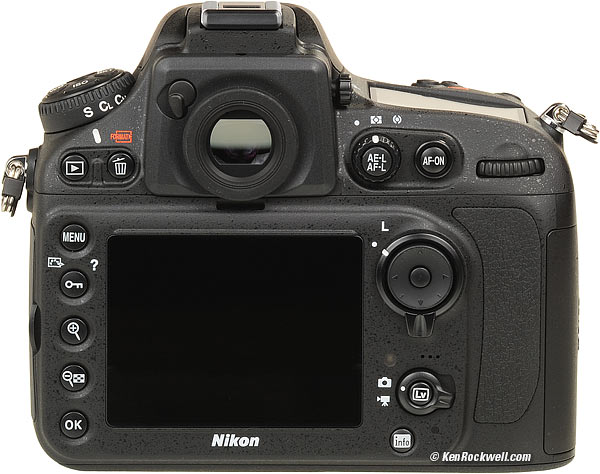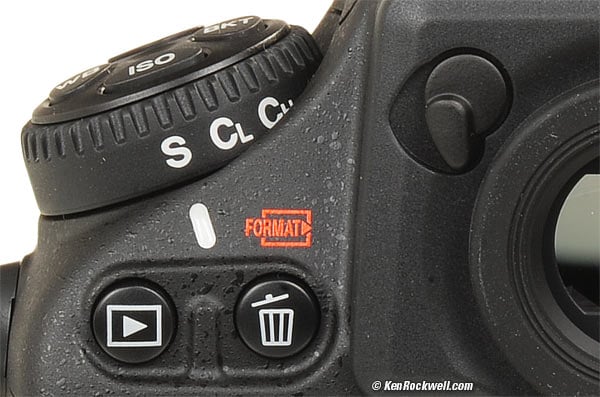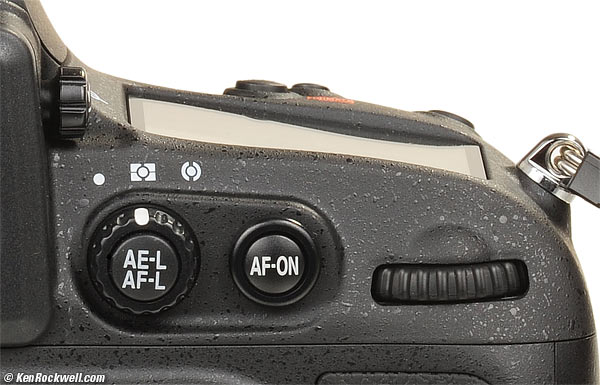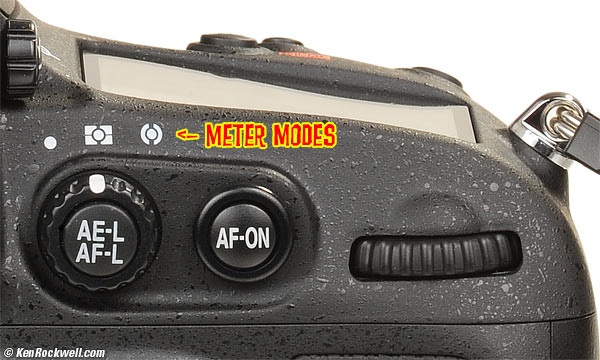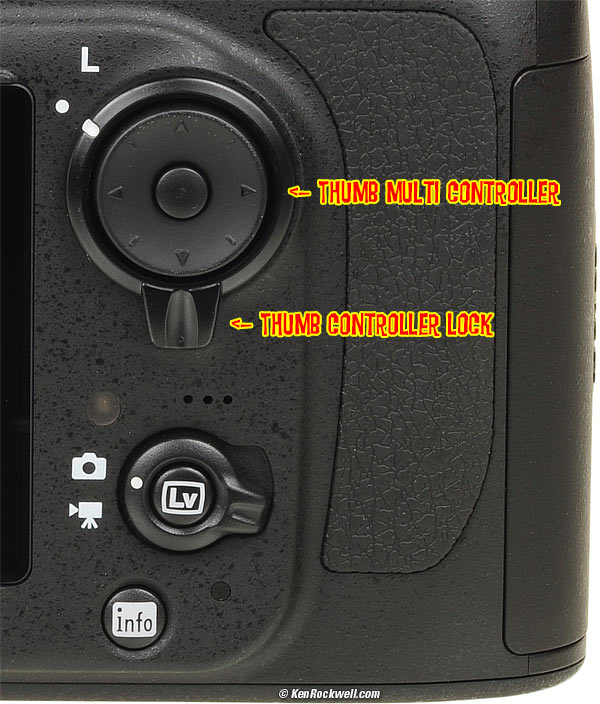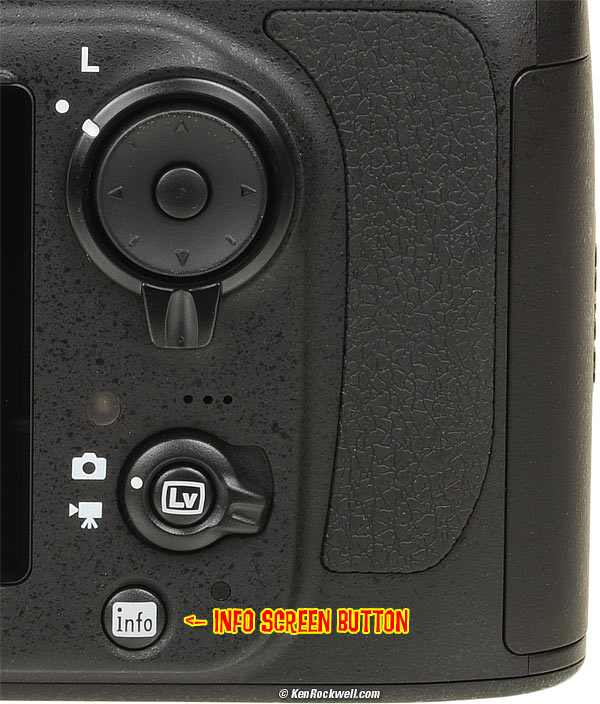Home Donate New Search Gallery Reviews How-To Books Links Workshops About Contact
Nikon
D800 and D800E User's Guide:
Rear Controls
© 2012 KenRockwell.com. All rights reserved.

July 2012 D800 and D800E Review Nikon Reviews Nikon Lenses All Reviews
Top of D800 and D800E User's Guide
Help me help you top
I support my growing family through this free website. The biggest help is when you use any of these links when you get anything, regardless of the country in which you live.
If you find this page as helpful as a book you might have had to buy or a workshop you may have had to take, feel free to help me continue helping everyone.
While free to read online, this page is formally registered and copyrighted, so it is unlawful to make copies, especially in the form of printouts for personal use or saving these pages or files. If you wish to make a printout for personal use, you are granted one-time permission to print from your browser (there is no PDF) only if you PayPal me $5.00 per printout, file save, or part thereof, unless of course you bought your D800 through one of my links. This is how I justify spending weeks away from my family writing and sharing all this for free online.
Thank you and thanks for your support!
Nikon D800 and D800E rear. enlarge.
Want free live phone support? In the USA, call (800) NIKON-UX, 24 hours a day, 365 days a year.
Left-Side Controls
Advance Mode Dial top
Advance mode control. enlarge.
This doesn't turn unless you press the release button just behind it, hidden behind itself in this photo.
This sets the frame advance rate, the Quiet mode, the self timer, and the mirror lock up:
S: Single Frame
One shot for each press of the shutter button, regardless of how long you hold it.
CL: Continuous Low
I use this setting. Press the shutter once and you get one photo. Hold it down and the D800 and D800E takes pictures continuously at any speed you choose in Custom Function d2.
If I need one shot I get one shot. If the light is dim and I want a few shots to ensure I get a sharp one, I hold the release down and make several from which I'll pick the sharpest. Faster selections make it more likely that I'll get two shots when I want just one.
Default is 3 FPS, which I use. You can set this to any integer between 1 FPS and 5 FPS in Custom Function d2.
The D800 and D800E really only go 4 FPS, except in the DX crop mode. If you select 5 FPS (which is the same as the CH setting next), the camera only goes at 4 FPS unless you're in DX.
CH: Continuous High
The D800 and D800E runs at 4 FPS as long as you hold down the shutter.
I don't use CH because it's so fast that I often get 2 or three shots when just one will do.
in DX crop mode only, it will run 5 FPS. You don't need to set anything, it knows, and will display this on the rear INFO screen.
Q (Quiet Mode)
This mode doesn't work. I never use it.
All it does is slow down the camera, but not make it any quieter.
Specifically, this mode disconnects the shutter cycle so that the mirror stays up until you remove pressure from the shutter button, at which time the mirror flips down and the rest of the shutter's cycle completes.
It's no quieter than the normal mode, and once the shutter is pressed, the finder is black until you release the pressure.
The Canon 5D Mark III's Quiet mode is much better than this. It's actually much quieter, and not much slower, and doesn't let the finder go black.
If you want a quiet camera, get the D7000, D3200 or the Canon 5D Mark III, not the D800.
Self Timer (clock icon)
Press the shutter and the D800 or D800E takes a picture some seconds afterwards.
We set the delay and how many shots are made each time in CFN c3.
Mup (Mirror Up)
Press the shutter and the mirror flips up.
Nothing happens until you press the shutter again, at which time the picture is taken and the mirror flips back down.
If you don't press the shutter a second time, it shoots by itself after 30 seconds.
A much better way to do mirror-up for low vibration is to use the much improved Exposure Delay mode.
Note 1
The Self Timer and Mirror Up modes are defective in design.
If you forget to set either back to the other modes (I always forget) you'll still be in these weird modes tomorrow! Worse, the Mirror up mode is still stupid, since you need to buy a $100 cable release to release the shutter after the mirror goes up.
The correct design for these two functions, as done on the Mamiya 7, is to add a dedicated self timer button. Press this button and the shutter fires several seconds later. On an SLR the correct implementation is to have the mirror flip up at the beginning of the self timer interval. You'd get sharper pictures, not have to screw with screwing and unscrewing expensive electronic cable releases, not have to remember a cable release, and not miss tomorrow's shots because you forgot and left the D800 and D800E selector in last night's position.
Note 2
If you have no cable release, you can use the Mup mode and wait 30 seconds.
30 seconds after you press the shutter, the D800 and D800E gets tired of waiting and fires its shutter and the mirror flips down.
Note 3
At default, the D800 and D800E need perfect locked focus to take a picture in S advance mode, and locked focus to start the Mirror Up or self timer modes. If you don't have perfect focus, the D800 and D800E ignore you in these modes. Sometimes off-brand lenses may not be sharp enough to get good enough focus to let the D800 and D800E take a picture in these modes, especially with other than the center AF sensor. You can set the D800 and D800E to shoot even if it's not in perfect focus in the Custom Settings Menu.
By default, the D800 and D800E take pictures whether or not they're in focus in the AF-C modes.
Play [>] Button top
Play button. enlarge.
Press it to see your pictures. Press again to turn them off.
There are a lot of trick play modes, like zooming all the way in with the center control button and being able to select among images with the dials.
My favorites are explained under the settings for the rear thumbswitch and the Command Dials.
Trash (also doubles as one of the two FORMAT buttons) top
With an image on the LCD, press once. You'll get an "Are you sure?" message. Press again and the shot's gone. The D800 and D800E ignore this button if you're not playing back.
Hold this along with its brother, the MODE button, to format a memory card.
MENU top
Nikon D800 and D800E rear. enlarge.
This gets you inside your D800 and D800E.
I'll cover what you can screw up with this in the 11 long pages that follow.
Key, [.-^-.] and ? button top
While in Menus: "?"
Press for more information about whatever you're setting, if you see a gray "?" on the lower left of the color LCD.
If no gray "?," then there is no help available.
While in Playback: "Key"
It protects (locks) the image from erasure.
Warning 1.): It marks the file so well that it won't empty out of my trash on my computer unless I go in and reset the file on my computer first!
Warning 2.): These images are erased from your memory card when you format anyway. Now you see why I don't use the lock feature.
While Idle or Shooting: [.-^-.] Picture Controls
Press this button, and the Picture Controls menu appears.
This is great for changing from VIVID to STANDARD color rendition, etc.
Magnifier (+) top
Works in Playback Only
Tap it to zoom in.
If you have multiple shots up at once, tap it to get to 4 or just one.
Trick: When you have multiple images up, spin the front knob to move up and down among the images, and move the rear dial to select left and right, presuming you've enabled this in custom setting f9.
Checkerboard (-) top
Works in Playback Only
Tap it to select one, four, nine or more shots up at once.
If zoomed, tap it to reduce the zoom (zoom out).
Trick: When you have multiple images up, spin the front knob to move up and down among the images, and move the rear dial to select left and right, presuming you've enabled this in custom setting f9.
OK top
While playing back at normal size: Tap it to get to the Retouch menu.
While playing back with zoom or with 4 or 9 images: Tap it to return to one image on-screen at normal size.
While in menus: Takes action on what you've set.
Top Center Controls
Nikon D800 and D800E rear. enlarge.
Eyepiece Blind (top left above eyepiece) top
Nikon D800 and D800E eyepiece blind lever. enlarge.
If you don't have your eye on the finder, light could sneak in and reduce your exposure, making your picture too dark. This might happen if you're on a tripod.
If so, just flick the lever to cover the eyepiece and eliminate the problem. It will appear gray when covered so you'll not forget and wonder why your finder went black!
AE-L AF-L & Meter Mode (Top left center) top
Nikon D800 and D800E rear top right controls. enlarge.
Hold this to lock exposure settings while shooting.
You may change what this button does in the Custom Setting Menu f6.
Metering Mode Selector top
Nikon D800 and D800E rear top right controls. enlarge.
This is set by twisting the ring around the AE-L AF-L button.
It has three positions: Spot, the dot on the left; Matrix, the rectangle in the middle, and Center Weighted, the circle on the left.
I always use Matrix, the center rectangle.
Matrix is a magic system which really figures out what you're shooting, even if it's very dark or very bright and white, and just gives the correct exposure. It sees in color, sees depth, it sees in over 1,000 places in the finder, and has an astounding amount of perception in getting exactly the exposure I want.
Even with Nikon's first Matrix meter in the Nikon FA of 1983, I could point the camera at anything, even right into the sun, and always get perfect exposures.
Sunrise, Mono Lake. (Nikon FA in P mode and Matrix, Nikon 600mm f/5.6 AI-s, Fuji Velvia)
I just pointed and shot; the Matrix meter does the exposure calculations so I can pay attention to the composition.
The meter in the D800 and D800E is many times better.
I never use center weighted, and I certainly never use spot. With the Matrix meter, just shoot. It's smart enough to do all the compensation and locking that you used to have to do in the older modes.
The other positions are left-overs from earlier decades. They are blind to color, blind to absolute luminance, blind to distance, and blind to relative position in the frame. Matrix sees in many dimensions at once, while these blind old meters see in only one dimension. The Center-Weighted (CW) meter was Nikon's most poplar meter in the 1960s and 1970s, and the Spot meter is left over from the 1980s.
The CW meter was useful in its day because it measured just the right area of the finder so you could point the camera at the main subject, set a manual exposure, recompose, and shoot. Unless the subject just happened to be the right tone, you'd always have to use exposure compensation for light and dark subjects. In the 1970s, AE cameras had AE locks, so you'd point, meter, lock, recompose, and shoot. What a pain!
The Spot meter sees only a small spot in the finder. It requires knowing the Zone System to use well, since few scenes actually have any tones at exactly Zone V from which to spot meter. See How to Use the Nikon Spot Meter.
AF-ON (Top center right) top
Nikon D800 and D800E rear top right controls. enlarge.
The AF button focuses the lens, but doesn't take a picture as does the shutter button.
This button is helpful if you disable the AF from activating when you press the D800 and D800E's shutter in CSM a4. If you do, then you can focus with this button, and have an AF lock when you release it.
I'd rather it was an AF LOCK like on the Nikon F4 or a self-timer, but Nikon didn't ask me about this one.
Right Center & Lower Controls
Nikon D800 and D800E thumb controller. enlarge.
Thumb Controller top
This is used for everything: menu navigation, selecting AF areas, scrolling through playback images and a whole lot more.
You can configure this button in custom settings f2 and f3.
I set mine to zoom way into an image when pressed in the center.
The L, lock, is an electronic lock-out.
It's smart: it only locks the AF selections; it doesn't lock you from anything else.
Because of this, if you can't select AF areas, check it because it often gets knocked. Even in L you can still do everything except select AF areas.
Trick: If you set a center push to zoom on playback, you can spin the rear dial to move to different images at the same position and zoom! This makes it easy to pick out the sharpest image. Unfortunately as soon as you hit the delete key it goes back to unmagnified, sort of making this less useful for in-camera selection and deletion.
[ Lv ] Button top
Nikon D800 and D800E thumb controller. enlarge.
Use the lever to select still photos or movies.
Press [Lv] to fire up Live View.
To get your D800 or D800E to focus (slowly) in Live View, press the AF-ON button or hold the shutter halfway.
To make a movie once in movie mode Live View, press the red Movie button near the shutter release.
To stop your movie, press the red Movie button again.
You change the settings for the picture and sound in the Shooting Menu.
You also can change the functions of several D800 and D800E buttons specifically in the movie mode in the Movies Custom Settings Menu.
The INFO button selects among various rear LCD display formats when pressed. This is how you call up the virtual horizon, audio level meters, etc.
INFO Button top
Nikon D800 and D800E INFO button. enlarge.
INFO calls up a display on the rear LCD of just about everything you might want to know.
I find this far more useful than the vestigial top LCD.
Press it again to change things, and you'll see the bottom part of the display change color so you can set those items.
To set them, wake up INFO screen with the INFO button, and press INFO again to highlight the settings at the bottom.
Highlight what you want to set with the Thumb Controller, and press the Thumb Controller center button to make the changes.
You can enable the power switch illuminator switch to wake up the INFO screen with CFN f1, which I do. You still need to tap the dedicated INFO button to make changes.
Top of D800 and D800E User's Guide
AUTOFOCUS
Setting the D800 and D800E's Autofocus System
KNOBS and BUTTONS
MENUS
PLAYBACK < < NEXT
Home Donate New Search Gallery Reviews How-To Books Links Workshops About Contact
